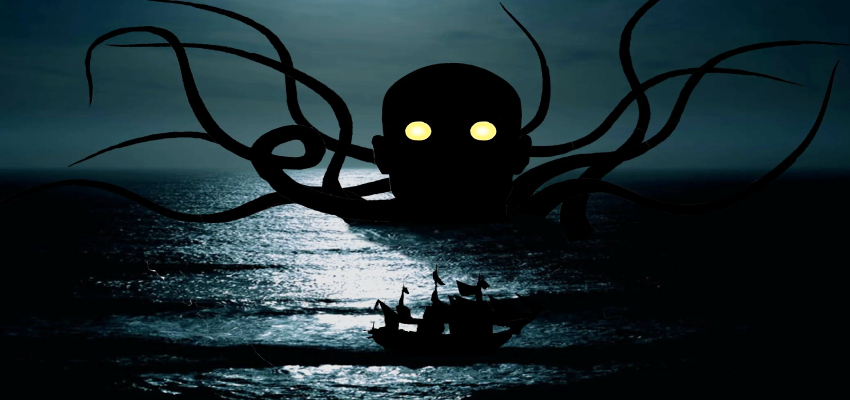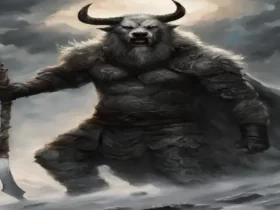The Yokai, type of monster from Japanese mythology, are known for their diversity and wide range of forms. They can be feared demons or benevolent spirits, and can take the shape of divine animals, living objects, and more. Due to this diversity, some Yokai are more well-known than others. One of the lesser known but mysterious Yokai is the Umibozu.
Umibōzu, also known as Umihōshi or Uminyūdō, is a creature from Japanese folklore that is said to appear to sailors on calm seas, causing the sea to become tumultuous. It is said to either sink the ship or demand a bucket or barrel from the sailors before proceeding to drown them. The only way to escape an Umibōzu is to give it a bottomless barrel and quickly sail away while it is confused. The origin of Umibōzu is not well known, but it is said to be a sea-spirit that has been sighted multiple times in Japan.
The creature known as umibōzu is known to attack ships in large groups, appearing as naked beings with a resemblance to bōzu. They cling to the ship’s hull and put out the fires in baskets. They are known to make vocalizations like “yaa yaa” while swimming and shrieking “aitata” when hit. A weakness of these creatures is said to be tobacco smoke, so having some on hand may save someone from an encounter with one.
Umibōzu are said to appear and suddenly disappear in the ocean, often at night, as giant black heads, and they are known to suddenly appear on calm sea surfaces and they enjoy wrecking water vessels. They are said to be a few meters to tens of meters in length, and are sometimes seen as monstrous bōzu, but some accounts mention smaller versions of the creature.
Like funayūrei, there are many stories that may relate to hallucinations, and the difference between hallucination events and Umibōzu encounters are not always clear. In some stories, funayūrei that sink ships are considered to be the same as umibōzu. However, unlike funayūrei who appear during stormy weather, umibōzu can sometimes appear on calm seas, and it is suggested that these creatures might be natural phenomena that were misinterpreted, such as cumulonimbus clouds, big waves, sea organisms or other natural phenomena. Some tales mention that umibōzu would ask for a ladle, and sometimes the stories about funayūrei and umibōzu are not distinguishable.
1Umibōzu Or Sea Monks Are Dark Humanoid Creatures With Shaved Heads & Having Body Parts Of Different Animals

In an early Edo period scroll, Umibōzu is depicted as a dark, humanoid creature with a shaved head and a mix of dog, sea serpent, and octopus characteristics. It has five tentacle-like appendages on its hands and fins running down its spine. The lower half of its body is not visible, adding to the mystery of what it looks like. It is often shown as a large, black figure that only rises from the ocean to its waist, with no known appearance of its lower half. Some stories suggest it has tentacles while others suggest it has two legs like a human. The figure is typically around 10 meters tall and is capable of breaking ships with its hands or arms. It is often depicted with a smiling expression and wide-open eyes that are said to pierce the sailors. The creature’s appearance is said to be similar to that of a monk or Buddha, but it is not clear if there is any religious significance to this.
2There’s A Tradition Of Tōhoku Region That Brings Umibōzu To Water Vessels

In the Tōhoku region, a tradition exists where the first fish caught while fishing is offered as a sacrifice to the gods. Failure to do so is said to result in an umibōzu, a sea monster, appearing and destroying the boat and abducting its owner. The nurarihyon, a creature often found in the Bisan Seto area, is known for its large round head and its habit of approaching boats in a slow and unpredictable manner, repeatedly approaching and receding, as a means of causing confusion.
3Some Stories Describes Umibōzu As A Spirit Of A Priest

The origin of the creature known as umibōzu is unknown and there are no specific stories that explain how it came to be. One theory is that it is the spirit of a priest who was cast into the sea by villagers and, unable to find rest, now haunts the ocean in the form of a dark shadow seeking revenge on those who cross its path.
4According To Some Legends Umibōzu Can Shapeshift Into A Woman
In Kesennuma Shima, Miyagi Prefecture, there are tales of umibzu changing into a beautiful woman and competing in swimming matches with humans. Umibzu are also rumored to have the ability to change their appearance. The same story is told in Iwate, but there it is claimed that those who accept the challenge will be instantly swallowed up. There are rumors that they would transform into a zat (blind person) and murder human women in Uwajima, Ehime Prefecture. While there are many tales of them attacking people, one that is said to exist in Uwajima is that anyone who sees an umibōzu will live a long time.
5Umibōzu of Kemiura Resembles With A Mighty Monkey
In Wakayama Prefecture, there is a type of umibōzu with a unique appearance known as the “umibōzu of Kemiura” that has been known to appear and disappear. In 1888, a newspaper reported that a creature fitting this description, resembling a large monkey with brown hair, orange eyes, and features such as a crocodile’s mouth, fish torso, lobster tail, and bull-like cry, was seen at Mii-dera with a height of about 7-8 shaku and a weight of about 60-70 kan.
6Nagano Prefecture Believes Umibōzu Looks Like Giant Buddha Statues

In Nagano Prefecture, there is a type of umibōzu that is said to inhabit rivers and is considered unique among all other provinces. According to legends, these creatures have large bodies and black heads that resemble giant Buddha statues and are said to only reveal their upper bodies above the water’s surface. In areas outside Japan, there are similar legends about sea creatures that have human-like features such as sea monks and sea bishops.
7Umibōzu Or Sea Monks Have Particular Time When Their Head Come Out Of The Sea
According to historical records, there were instances where the creature called Umibōzu would rise out of the sea and stay above ground for three days in Kaizuka, Izumi. During this time, children were advised not to go outside until the creature returned to the sea. Additionally, in Kuwana, it was said that Umibōzu would appear at the end of the month and as a result, it was prohibited to set sail during this time. However, there is a legend of a sailor who disobeyed this ban and when the Umibōzu appeared, it asked if it was fearsome. The sailor replied that the only thing more fearsome was sailing the seas, and upon hearing this, the Umibōzu disappeared. Similarly, there is another legend about a “zatō gashira” (blind man head), a blind creature that would appear above the sea and ask if it was fearsome, if someone answered scared, it would say “You should not be going out to sea at the end of the month” and disappear.
8Umibōzu Is A Creature Of Ocean So They Were Only Encountered To Sailors & Boat Drivers

Umibōzu is a sea creature that only appears in the ocean, typically during calm and fair weather. Its sudden emergence from the ocean can cause waves and destroy or flip ships. It is often accompanied by a change in weather, which puts ships in immediate danger. The creature is usually called the “sea monk” because of its appearance, but it has no ties to any religion. Its attacks on ships and sailors are random and have no correlation with any actions or beliefs of the victims. Survivors of encounters with Umibōzu usually escaped by giving it a bottomless barrel, and it is said that the creature is not intelligent enough to understand why it can’t scoop water from the barrel.
9The Umibozu Named Kuro Nyūdō Seek Sacrifice To Forgive Their Victims
The Kii Zōdan Shū of the Edo Period has records of a specific type of Umibōzu called “kuro nyūdō” (black priest initiates). One story from the records tells of a boatman named Zenchi, who disregarded the belief that having only one woman on board would bring good luck and brought his wife on a voyage from Ise Province to Cape Irago. However, during the voyage the boat encountered a severe storm, and the shipowner believed that the dragon god was angered, partly due to the presence of a woman on board. Despite trying to appease the dragon god by throwing things that it might like into the sea, the storm continued until the kuro nyūdō appeared. This creature was described as having glittering eyes, a head that was 5 to 6 times the size of a human, and a 2 shaku long horse-like mouth. The story goes that Zenchi’s wife decided to sacrifice herself by throwing herself into the ocean, and the kuro nyūdō devoured her, after which the storm stopped. These Umibōzu are later known as fallen dragon gods who seek sacrifices.
10Sea priest, Yokai Turtles, Fune Nyūdō Are Some Similar Version Of Umibozu Monster

In the Haidaoyizhi literature by Wang Dahai, there is a mention of a mythical creature known as the “umi oshō” (sea priest). This creature is said to resemble a human, but has a tear from the mouth to the ear and is known for its loud laughter. These Umi oshō are said to be feared because their appearance is often followed by a storm surge. Some people suggest that these creatures may be sea turtles that are seen as yōkai. Another similar creature is mentioned in the Honchō Goen of the Hōei era, called “fune nyūdō” (boat priest initiate) which were described as having a height of 6 to 7 shaku, no eyes, nose, or limbs. It is said that if you see one of these creatures, it is necessary to say nothing and pretend to have seen nothing, as speaking would cause the boat to sink instantly. In Yura, Awaji Island, it is said that one can be spared by tossing the most precious cargo into the sea.
11Umibozu Anecdotal Sightings Are Officially Published In Newspapers
In 1971, a fishing boat off the coast of Japan encountered a large creature with many wrinkles and large eyes that surfaced when the boat’s fishing line was cut. The creature disappeared before it could be identified, and when an officer from a research lab heard of the incident, he believed the fishermen may have mistaken a fish or whale for a monster. Another eyewitness reported that half of the creature’s body was about 5 feet long, leading to speculation that the entire creature was much larger. These accounts were published in a newspaper in July of that year.





